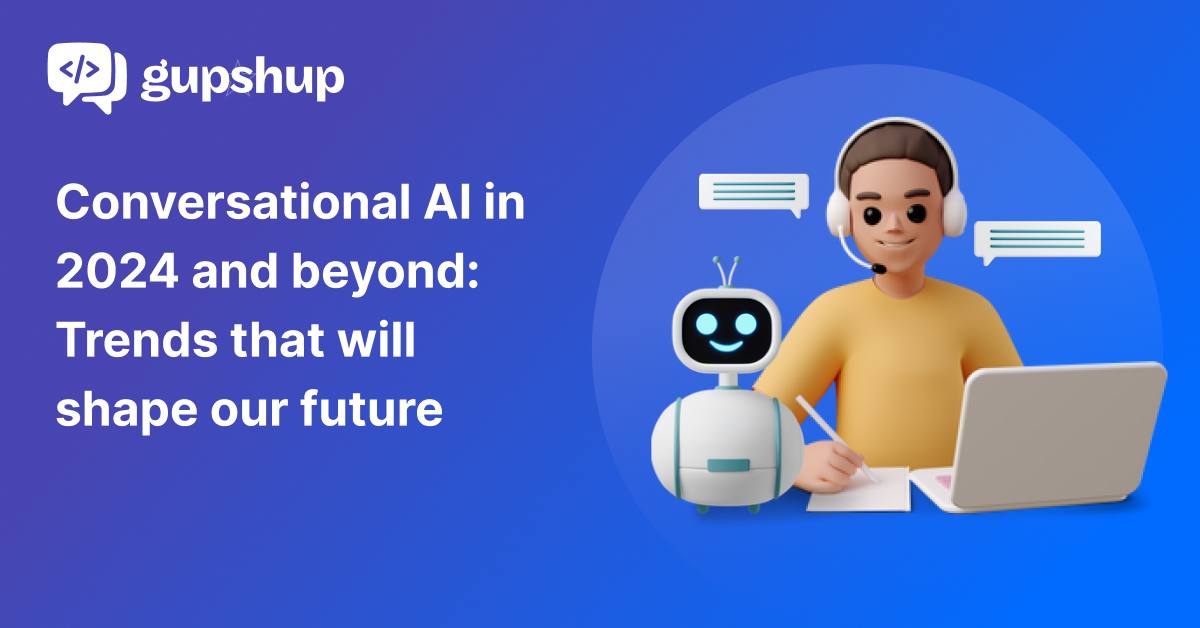The Future of Conversational AI: Top Trends and Predictions for 2024

Conversational artificial intelligence (AI) has seen rapid advancement in recent years, with chatbots and voice assistants like Siri and Alexa becoming commonplace. As natural language processing technology continues to evolve, we can expect even more capable and useful applications of conversational AI over the next few years. Here we explore some of the top trends that are likely to be witnessed in this space in 2024 and beyond.
Exponential Improvements in Underlying AI Capabilities
One of the most important factors driving progress in Conversational AI is exponential improvements in the underlying deep learning algorithms used to parse, understand, and generate natural language. According to the trends outlined in AI expert Ray Kurzweil’s Law of Accelerating Returns, core AI capabilities tend to double in power and sophistication every 12-18 months. This means that by 2024, the core natural language processing algorithms and neural networks that power conversational agents may be 4-16 times more sophisticated than current models.

As these foundational AI capabilities grow more powerful, they will enable conversational agents to handle far more complex dialogues spanning a wider range of topics. They will also become much better at responding appropriately to contextual cues and exhibiting more human-like conversational capabilities like empathy and humor. Consumer expectations of how smart and useful conversational AI can be will likely be exceeded on a regular basis.
Advances in Multilingual Conversational AI
Another key trend will be rapid advances in supporting multilingual conversational experiences. As companies continue expanding their conversational AI products to global markets, and to various regions within a country, the ability to smoothly deal with interactions spanning multiple languages becomes critical. AI advancements related to language detection, real-time translation and transfer learning across high-resource languages like English as well as low-resource languages will help serve broader demographics. For example- Gupshup’s Generative AI capabilities are already solving for language translations on the go, helping brands translate templates from English to Hindi, Spanish, Portuguese or any other language.

Advances in Multimodal Conversational AI
An emerging trend is the integration of multiple modalities like voice, vision, gestures and gaze tracking to enable more immersive, multi-turn conversational experiences with AI agents. With the addition of things like emotion and sentiment recognition powered by computer vision, conversational AI can become perceptive of non-verbal cues and subtle subtexts within conversations. This can enable much more natural, contextual and meaningful dialogue between human users and AI assistants.
For example, AI assistants with multimodal inputs can potentially appear more empathetic in two-way spoken conversations with humans. As underlying speech, vision and sensor AI accelerates further, expect richer blends of modalities to significantly enhance conversational interfaces by 2024.
Conversational AI for Enterprise and Specialized Domains
Beyond consumer applications, conversational AI also has tremendous potential to reshape workflows and drive gains in efficiency and productivity across enterprises and specialized professional domains. Intelligent conversational agents integrated into corporate networks can help automate routine tasks. AI assistants designed specifically for banking, retail, healthcare, customer service and other verticals can enable smoother engagements and ensure accurate domain-specific information retrieval. Gupshup’s family of Large Language Models (LLMs)- ACE LLM offers fine-tuned, enterprise and domain specific chatbots for various functions such as marketing, commerce and support and industries such as- retail, BFSI, travel etc.

With the help of techniques like transfer learning – where models trained on very large datasets are fine-tuned for specialized applications – domain-specific conversational AI models will continue to get better at understanding niche terminology, data formats and user intents within different industries and fields. Advances in data security and privacy will also encourage large-scale adoption of conversational AI across the enterprise.
The Democratization of Conversational AI Development
The development of enterprise-grade conversational AI currently requires significant data science and engineering expertise. But expect more democratization in this space from low-code/no-code AI development platforms as well as open-source conversational AI frameworks. These tools will enable non-technical domain experts to create relatively sophisticated conversational agents tailored to their business needs without intensive programming.
With accessible tools for annotating training data, configuring natural language models, designing dialog flows and integrating across data sources and workflows, domain specialists like doctors, customer support reps and more can take greater ownership of building and optimizing conversational AI to automate routine tasks. This will greatly expand the practical application of conversational AI across many verticals.
Ongoing Challenges with Transparency and Bias
As conversational AI continues to advance, there will be ongoing public scrutiny around challenges like lack of transparency, bias, unfairness and issues related to privacy and consent. More research, governance and continuous evaluation of real-world performance will be critical for conversational AI. Particularly, for enterprise-scale generative AI to be successful, simply having high-quality output is not enough. Equally critical is ensuring the reliability, responsibility, and controllability of the system. Companies need to have measures in place that address potential issues with bias, factual inaccuracies, irrelevant text, and adherence to regulations and compliance standards. Building guardrails against unethical AI behavior while still producing useful, on-topic output poses a major challenge that organizations must grapple with for real-world deployment.
The Next Frontier: Creative AI Conversational Agents
Further in the future, advancements in areas like transformer networks, reinforcement learning, meta learning and multimodal AI will pave the way for the next frontier – creative conversational AI agents. Systems endowed with imagination, emotional intelligence and even rudimentary forms of self-awareness could engage humans in profound discussions about philosophy, art and the human condition.
While such futuristic applications may be farther than 2024, active research and experiments in domains like sentiment intelligence, social IQ, creativity amplification, knowledge representation and common sense reasoning will set the gears in motion for engineered conversational entities that can form deeper connections with humans. The not-too-distant future promises a rich palette of intelligent, inspiring and enjoyable conversations with our own AI companions.
Conclusion
From lightning-fast improvements in natural language processing to proliferation of voice assistants and advances in emotion recognition – conversational AI is poised for many technology leaps in 2024 and beyond. As the supporting AI gets exponentially more sophisticated, we can expect more capable, versatile and specialized conversational agents across consumer and enterprise settings. But responsible governance and ethical considerations will be key as these AI systems continue permeating critical aspects of human-computer interaction and decision making. Overall however, the future remains bright for this rapidly emerging field at the intersection of language and intelligence.




